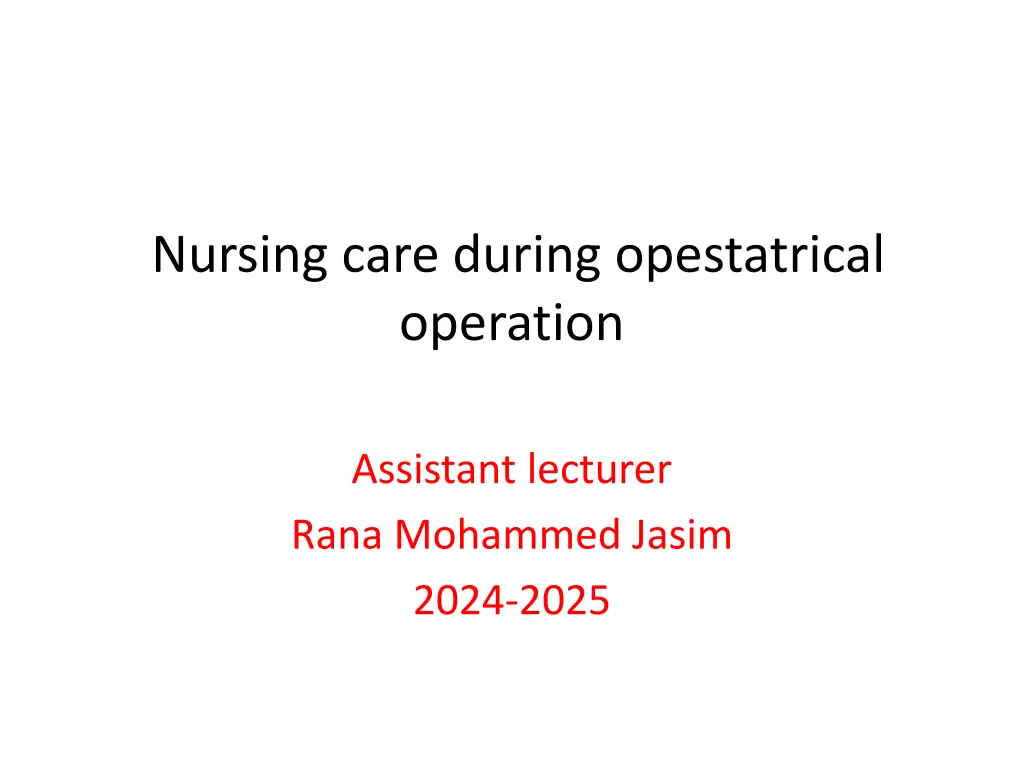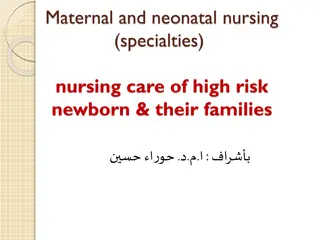
Nursing Care During Obstetrical Operation: Induction, Augmentation, and Methods
Learn about the nursing care involved in induction and augmentation of labor during obstetrical operations. Understand the indications, contraindications, methods, and risks associated with these processes to ensure safe and effective care for mothers and babies.
Download Presentation

Please find below an Image/Link to download the presentation.
The content on the website is provided AS IS for your information and personal use only. It may not be sold, licensed, or shared on other websites without obtaining consent from the author. If you encounter any issues during the download, it is possible that the publisher has removed the file from their server.
You are allowed to download the files provided on this website for personal or commercial use, subject to the condition that they are used lawfully. All files are the property of their respective owners.
The content on the website is provided AS IS for your information and personal use only. It may not be sold, licensed, or shared on other websites without obtaining consent from the author.
E N D
Presentation Transcript
Nursing care during opestatrical operation Assistant lecturer Rana Mohammed Jasim 2024-2025
Induction of labor &augmentation of labor. (IOL) is the intentional initiation of labor before it begins naturally.(artificially) Augmentation of labor is: the stimulation of contractions after they have begun naturally.(for To strengthen and regulate UCs and To shorten the length of labor) Induction of labor
Indications for Induction 1. Ruptured membranes without spontaneous onset of labor 2. Infection within the uterus 3. Post-term pregnancy 4. Medical problems during pregnancy, such as diabetes, hypertension 5. Fetal problems, prolonged pregnancy, or incompatibility between fetal and maternal blood types. 6. Fetal death
Contraindications to Induction Labor is not induced in the following conditions 1. Placenta previa, Vasa previa 2. Umbilical cord prolapse 3. Abnormal fetal presentation ,transverse fetal lie 4. Abnormal FHR 5. A prior classic uterine incision 6. Vaginal bleeding with unknown cause 7. Abnormal size or structure of the mother s pelvis 8. Pelvic structure abnormality.
Method of induction of labor A-Non-pharmacological Methods to Stimulate Contractions (Naturally) 1. Sexual activity 2. Nipple stimulation 3. Walking 4. Bath. 5. Castor oil 6. Cinnamon and curry
B-Pharmacological and Mechanical Methods to Stimulate Contractions 1-Cervical Ripening: Cervical ripening is the physical softening of the cervix that leads to effacement and dilation.. dinoprostone gel (Prepidil) ripens the cervix and stimulates uterine muscle). Misoprostol (Cytotec) can used for both cervical ripening and induction of labor. 3- Amniotomy is the artificial rupture of membranes (AROM) by inserting a cervical hook (Amniohook) through the cervical os.
Risk of amniotomy 1. Umbilical cord prolapse 2. Maternal infection 3. Bleeding and women discomfort
4-Oxytocin : ( normally produced in the hypothalamus and released by the posterior pituitary.) Oxytocin causes the uterus to contract used to induce labor, strengthen labor contractions during childbirth, control bleeding after childbirth Oxytocin :is diluted in an(slow IV solution). Complications of Augmentation of Labor 1. fetal compromise 2. uterine rupture 3. uterine hyperstimulation 4. postpartum hemorrhage 5. abruptio placenta 6. rapid labor, leading to laceration of cervix ,vagina, perineum, and fetal trauma
Nursing care during induction and augmentation of labor 1. Explain induction and augmentation to the client 2. Administer low-dose oxytocin and increasing the dose as recommended . 3. Assess cervical dilation 4. assesse and record Fetal heart and uterine contraction 5. assesse maternal vital signs 6. observe & check the rate of flow of infusion
( Lacerations of the birth canal)) A laceration is an uncontrolled tear of the tissues that results in a jagged and irregular wound 1. laceration of cervix Laceration occurs in forceps delivery with incomplete cervical dilatation, or in rapid delivery of head in breech presentation, or Scar of cervix from previous injury may tear
2. Laceration of perineum & vagina Laceration of 4 stages: 1) First degree: Involves the superficial vaginal mucosa or perineal skin 2) Second degree: Involves the vaginal mucosa, perineal skin, and deeper tissues of the perineum 3) Third degree: Same as second degree, plus involves the anal sphincter 4) Fourth degree: Extends through the anal sphincter into the rectal mucosa
Episiotomy is also known perinotomy is a surgical incision of the perineum and the posterior vaginal wall during second stage of labor to quickly enlarge the opening for the baby to pass through. Indications of episiotomy 1. When perineum threaten to tear: indicated in primigravida . 2. When there is delay in delivery. 3. Forceps delivery. 4. Breech delivery: to reduce risk of intracranial hemorrhage. 5. Fetal distress: when fetal distress at 2ndstage of delivery. 6. Mother exhaustion 7. Macrocosmic baby
Types of episiotomy Midline (median)extending directly from the lower vaginal border toward the anus Mediolateral extending from the lower vaginal border toward the mother s right or left(most common) lateral
Layers of perineal repair: 1) Vaginal mucosa & submucosal tissue . 2) Perineal muscles. 3) Skin & subcutaneous tissue.
Repair of episiotomy: 1. Close the vaginal mucosa using continuous 1-0 absorbable suture. 2. Close the perineal muscle using interrupted 1-0 absorbable sutures. 3. Close the skin using interrupted (or subcuticular) 1-0 absorbable sutures Management - suture episiotomy in layers - don't leave any space between layers to prevent hematoma - daily bathing is advised - keep the wound dry - antibiotic is given when there is a risk of infection - analgesia is given when there is discomfort - If the bowel not acted by 4thday,glycerin suppository may be used -A high-fiber diet and adequate fluids help to prevent cons
Forceps delivery Obstetric forceps is a double-bladed metal instrument used for extraction of foetal head. This instrument is applied to foetal head and then the operative uses traction to extract the foetus, typically during a contraction while the mother is pushing. Forceps also used for extract the fetal head through the incision during cesarean birth.
Indication of forceps delivery Maternal and fetal : 1. Prolonged second stage of labor. 2. Maternal exhaustion 3. Maternal illness such as heart disease, hypertension, or other conditions that make pushing difficult or dangerous. 4. . Fetal distress in second stage of labor 5. Post date gestation 6. Intra-partum infection 7. Passage of meconium
Complication Maternal include : 1- lacerations of the cervix, vagina, or perineum; 2- Hematoma 3- extension of the episiotomy incision into the anus 4- Perineum wound infection. 5- Bladder injury Newborn includes : 1- ecchymosis, 2- facial and scalp lacerations, 3- facial nerve injury( palsy), 4- Trauma to the eyes. 5- fetal skull fracture 6- Cephalohematoma (collection of blood between a baby's scalp and the skull)
Conditions to be fulfilled before applying forceps (prerequisites) 1. Full cervical dilatation. 2. The head must be engaged.(Engagement) 3. The bladder should be empty 4. Rupture membranes 5. The presentation must be suitable 6. Adequate pelvic outlet. 7. Lithotomy position 8. Episiotomy 9. The uterus should be contracting to help pushing the fetus.
((Caesarian Section)) A cesarean birth is the delivery of the fetus through an incision in the abdomen and uterus. Classification: Traditionally, caesarean sections have been classified as elective OR emergency Types of uterine incisions: 1-A classic (vertical) incision 2- low transverse incision ; today, the low transverse incision is more common
Indications of Caesarian section 1. Previous surgery on the uterus. 2. Faults in birth canal: Cervical or vaginal stenosis 3. Inability of the fetus to pass through the mother's pelvis: Cephalopelvic disproportion. 4. Fetal mal-presentation : ( brow, breech) and transverse lie. 5. Umbilical cord prolapse. 6. Fetal distress. 7. Fetal size more than 4.5 kgm (Diabetic mother) 8. Placenta previa or abruption placenta 9. Infertility 10. Maternal indications: in cardiac or respiratory diseases, hypertension, diabetic. 11. Multiple pregnancy
Anatomical layers of the abdomen incised are: 1) Skin. 2) Fat. 3) Fascia, Rectus sheath. 4) muscle (Rectus abdomens) . 5) Abdominal peritoneum. 6) Pelvic peritoneum. 7) Uterine muscle.
Complication of S/C 1-Wound infection 2-Heamatoma. Hemorrhage 3-paralytic ileus 4-injury to the urinary tract. 5-blood clots 6-Respiratory complication 7-Pulmonary embolism 8-injury of the baby 9-socio-economic : cost 10-Scar tissue and difficulty with future deliveries.
Pre-operative nursing care 1. Privacy, prepare and check the obstetric equipment. 2. Give psychological support, provides essential information about procedures; Personal hygiene 3. Removal of dentures, nail polish, and jewelry ,lenses 4. Assess the time of last oral intake and what was eaten 5. Assess for allergies (drug) 6. Laboratory test: CBP, blood clotting, cross-match. 7. Checking maternal vital signs. 8. Checking fetal heart. 9. Emptying urinary bladder by catheter. 10. Cannula: I.V glucose saline drip is inserted.
Postoperative 1. Giving I.V fluid for 1st 24 hrs is given. 2. Assess maternal vital signs every 15 minutes the first hour, every 30 minutes the second hour. 3. Oxytocin is usually added to IV fluids to reduce the risk postpartum hemorrhage related to uterine atony. 4. Palpate the uterus (firmness, location ) 6. Assess lochia for color, quantity , and presence of large clots, and PPH 7. Abdominal dressing for drainage.
8. Daily breast care is carried out & breast feeding is encouraged earlier. . 9. Giving analgesic drug to let the mother comfortable & in rest. 10. Prophylactic antibiotic is given pre &post-operative. 11. Remove stitches at day 5-7 after operation. 12. Teach the woman to observe for signs of infection (foul- smelling lochia, elevated temperature, increased pain, redness and edema at the incision site






















